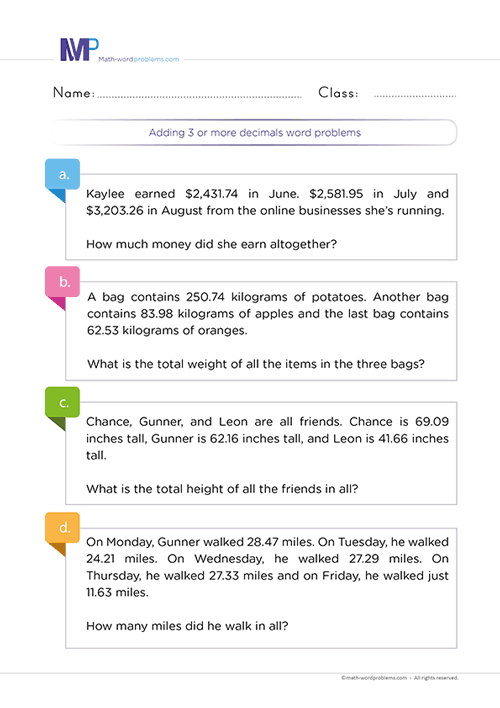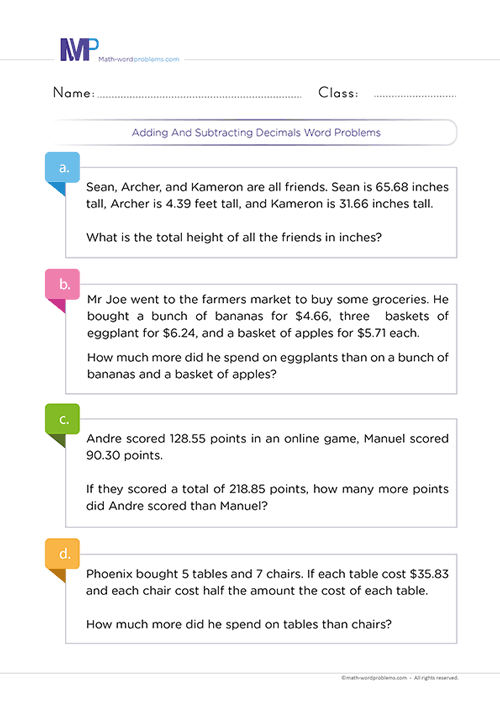 How to add 3 or more decimal numbers word problems
How to add 3 or more decimal numbers word problems
With our step-by-step guide on how to add 3 or more decimal numbers word problems, your fourth graders will discover simple tips and strategies for arriving at accurate answers effortlessly.
We know that word problems belong to the most challenging problem types that kids always encounter. Hence, we are designing this step-by-step guide with powerful strategies to motivate kids to learn how to add 3 or more decimal numbers word problems.
Steps on how to solve addition of 3 or more decimals word problems
As mentioned above, these steps on how to solve addition of 3 or more decimals word problems will enhance your 4th Grader's ability to solve complex decimal addition problems efficiently.
In line with this step-by-step method of adding 3 or more decimal numbers word problems, your kids will learn how to better understand and translate the problem statement into a solvable mathematical equation.
It is equally interesting that we will include some challenging yet thrilling examples and strategies for adding decimals word problems.
Step 1: IDENTIFY THE PROBLEM
To identify the problem, carefully read the entire word problem and highlight facts such as numbers, important keywords, and what the problem wants you to solve.
- When we talk about addition of decimals word problem, these are the most important keywords you’ll come across: add, plus, more, total, increase, together/altogether, combined, sum, grow, join, both, etc.
- ***One key Element for learners to understand is that they should not always rely on keywords alone. That is to say; the same keyword can have different meanings in different word problems.
- For this reason, we reiterate on the importance of reading the question very carefully to understand the situation that the word problem is describing, then figure out exactly which operation to use***
Step 2: STRATEGIZE AND DETERMINE THE OPERATIONS
How will you solve or tackle the problem?
One key thing you should remember is that each word problem may require a different format. Hence, the key points below will enable young math learners to tackle any format however it comes.
- First, the keyword in the word problem will help clarify the operation that you need to carry out.
- On the other hand, know that you must not rely merely on keywords. Instead, try to understand the situation that the problem is describing.
- After knowing which operation you will perform, construct short expressions/sentences representing the given word problem. This visual representation of the most vital information will make it easier to solve the word problem.
Step 3: SET UP A NUMBER SENTENCE AND AN EQUATION
- After knowing which operation to perform, construct short phrases to represent the given word problem. This visual representation of the most vital information makes it easier to solve the word problem.
- Then, write down a numerical equation representing the information given in the word problem.
Step 4: SOLVE THE PROBLEM
Now, after writing down the math problem (numerical equation), you can go ahead and solve the problem using any addition method of your choice, preferably the column method. I.e., add the decimal values by arranging the decimal point to line up.
Also, use zeros as place value holders, if need be, to solve the word problem. Furthermore, do not forget to include the unit of measurement in the final answer.
Step 5: VERIFY YOUR ANSWER
Finally, check your work to make sure that your answer is correct. For instance, estimate the answer and see if it is close to what you expected. However, if the answer is not what you expected, go back to step one and start all over again.
Examples on how to add 3 or more decimals word problems
Example one:
Step 1:First, the important numbers in the word problem are $2,361.2, $2,562.75, and $3,789.5. The keyword(s) found in the word problem is “altogether.”
Step 2:Ask yourself, “How can I solve this problem?” You see that the keyword found in the word problem calls for an addition operation.
Construct short phrases to represent the given word problem, then write down a numerical equation representing the information in the word problem.
- Amount of money that she earned in June = $2,361.2.
- Amount of money that she earned in July = $2,562.75.
- Amount of money that she earned in August = $3,789.5.
- Therefore, the amount of money that she earned altogether = the amount that she earned in June + the amount that she earned in July + the amount that she earned in August.
Step 3:Then, write down a numerical equation for each bolded sentence in step 2 above to solve this word problem:
$2,361.2 + $2,562.75 + $3,789.5 = ?
Step 4:From step 3 above, stack the values in the equation you formed above so that the decimal points line up in the addends and sum. Also, use zeros as place value holders, if need be, to solve the word problem. Moreover, do not forget to include the unit of measurement in the final result.
So, she earned $8,713.45 altogether.
Step 5: Finally, check your work to ensure your answer is correct. For example, estimate the answer and see if it is close to what you expected. However, if the answer is not what you expected, go back to step one and start all over again.
Example Two
Step 1: First, the important numbers here are 26.7, 9.3, 20.96, 25.10, and 7.21. The keyword(s) found in the word problem is “altogether.”
Step 2: Next, ask yourself, “How can I solve this problem?” From the keyword found in the word problem, it shows that you have to perform an addition operation.
Step 3: Construct short phrases to represent the given word problem. Also, write down a numerical equation representing the information given in the word problem.
- Distance he walked on Wednesday = 20.96 miles.
- Distance he walked on Thursday = 25.10 miles.
- Distance he walked on Friday = 7.21 miles.
- Therefore, the number of miles he walked in all = the distance he walked on Monday + the distance he walked on Tuesday + the distance he walked on Wednesday + the distance he walked on Thursday + the distance he walked on Friday.
26.7 + 9.3 + 20.96 + 25.10 + 7.21 = ?
Step 4:From step 3 above, stack the values in the equation you formed above so that the decimal points line up in the addends and sum. Also, use zeros as place value holders if need be, to solve the word problem.
Finally, remember always to include the unit of measurement in your final answer.
Using the long multiplication method, we have
So, he walked 89.27 miles in all.
Step 5:Finally, check your work to ensure your answer is correct. For example, estimate the answer and see if it is close to what you expected. However, if the answer is not what you expected, go back to step one and start all over again.





